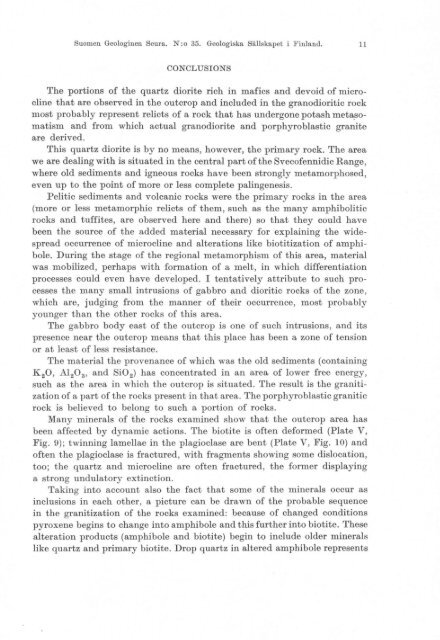COMMISSION GEOLOGIOUE - Arkisto.gsf.fi
COMMISSION GEOLOGIOUE - Arkisto.gsf.fi
COMMISSION GEOLOGIOUE - Arkisto.gsf.fi
You also want an ePaper? Increase the reach of your titles
YUMPU automatically turns print PDFs into web optimized ePapers that Google loves.
Suomen Geologinen Seura. N: 0 35. Geologiska Sällskapet i Finland. 11<br />
CONCLUSIONS<br />
The portions of the quartz diorite rich in ma<strong>fi</strong>cs and devoid of microcline<br />
that are observed in the outcrop and included in the granodioritic rock<br />
most probably represent relicts of a rock that has undergone potash meta.somatism<br />
and from which actual granodiorite and porphyroblastic granite<br />
are derived.<br />
This quartz diorite is by no means, however, the primary rock. The area<br />
we are dealing with is situated in the central part ofthe Svecofennidic Range,<br />
where old sediments and igneous rocks have been strongly metamorphosed,<br />
even up to the point of more or less complete palingenesis.<br />
Pelitic sediments and volcanic rocks were the primary rocks in the area<br />
(more or less metamorphie relicts of them, such as the many amphibolitic<br />
rocks and tuf<strong>fi</strong>tes, are observed here and there) so that they could have<br />
been the source of the added material necessary for explaining the widespread<br />
occurrence of microcline and alterations like biotitization of amphibole.<br />
During the stage of the regional metamorphism of this area, material<br />
was mobilized, perhaps with formation of a melt, in which differentiation<br />
processes could even have developed. I tentatively attribute to such proces<br />
ses the many smaH intrusions of gabbro and dioritic rocks of the zone,<br />
which are, judging from the manner of their occurrence, most probably<br />
younger than the other rocks of this area.<br />
The gabbro body east of the outcrop is one of such intrusions, and its<br />
presence near the outcrop means that this place has been a zone of tension<br />
or at least of less resistance.<br />
The material the provenance of which was the old sediments (containing<br />
K 2<br />
0, AI 2 0 a , and Si0 2 ) has concentrated in an area of lower free energy,<br />
such as the area in which the outcrop is situated. The result is the granitization<br />
of apart of the rocks present in that area. The porphyroblastic granitic<br />
rock is believed to belong to such a portion of rocks.<br />
Many minerals of the rocks examined show that the outcrop area has<br />
been affected by dynamic actions. The biotite is often deformed (Plate V,<br />
Fig. 9); twinning lamellae in the plagioclase are bent (Plate V, Fig. 10) and<br />
often the plagioclase is fractured, with fragments showing some dislocation,<br />
too; the quartz and microcline are often fractured, the former displaying<br />
a strong undulatory extinction.<br />
Taking into account also the fact that some of the minerals occur as<br />
inclusions in each other, a picture can be drawn of the probable sequence<br />
in the granitization of the rocks examined: because of changed conditions<br />
pyroxene begins to change into amphibole and this further into biotite. These<br />
alteration products (amphibole and biotite) begin to include older minerals<br />
like quartz and primary biotite. Drop quartz in altered amphibole represents
















